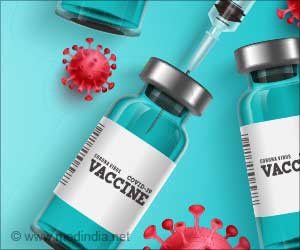New findings prompt the launch of a human clinical trial for a chemically stabilized coronavirus peptide.

Novel compound protects against infection by virus that causes COVID-19, preliminary studies show
Go to source). If the compound called a stapled lipopeptide, proves effective as a nasal spray in the trial, it could be the basis for a new drug modality to prevent or treat COVID-19, say the authors of the study,
Because such compounds foil a mechanism used by many types of viruses to enter and infect cells, stapled lipopeptides may also be effective against dangerous and potentially deadly viruses such as RSV, Ebola, and Nipah, as the authors also demonstrate in their study.
‘Compounds obstructing the "landing gear" of various viruses can protect against COVID-19 infection. These findings have led to the initiation of a human clinical trial for a chemically stabilized coronavirus peptide.
#covid19, #viruses, #coronavirus, #nasalspray
’





Advertisement
Viral 'Landing Gear' to Thwart COVID-19
"Although vaccines, monoclonal antibodies, and small molecule drugs have played a crucial role in protecting people from life-threatening COVID-19 infection, there remains a critical gap in the treatment arsenal," says Loren Walensky, MD, PhD, Physician and Principal Investigator, Linde Program in Cancer Chemical Biology at Dana-Farber/Boston Children’s Cancer and Blood Disorders Center. He led the research with Gregory Bird, Ph.D., of Dana-Farber, and Robert Davey, Ph.D., of Boston University’s National Emerging Infectious Diseases Laboratories (NEIDL).“The constant evolution of the virus and the emergence of new variants has markedly decreased the effectiveness of immune-based approaches, requiring periodic reformulation of vaccines. What has been missing are fast-acting, easy-to-administer, and resistance-proof agents that can be used before or after exposure to the virus to directly prevent infection or reduce symptoms. Our study is an encouraging indication that stapled lipopeptides offer that potential,” Walensky added.
“It was exciting to see how these peptides, which work by jamming the gears of the virus infection machine, moved quickly from a basic idea on paper to being effective with the viruses and in real disease models,” said Robert Davey, PhD, Professor, Microbiology at Boston University’s NEIDL.
“This was a great collaboration that started in the very first days of the pandemic when we wanted to work out a treatment for SARS-CoV-2 using the great biocontainment resources we have at Boston University. Our two labs worked very well together, and this is something we will continue to do in the future on other viruses that I work on like Ebola.”
Unlike mRNA vaccines, which are a form of immune-based therapy that provides delayed protection and also requires periodic administration due to viral mutation and/or waning immunity, the stapled lipopeptides developed by Walensky's lab act directly on SARS-CoV-2, the coronavirus responsible for COVID-19, interfering with its ability to infect healthy cells.
Because this approach does not use the immune system as an intermediary, it is especially promising for people with weakened immune systems, either due to their disease or treatment with immunosuppressive agents, such as chemotherapy.
Walensky's lab has pioneered the development and application of stapled peptides for nearly 20 years.
These unique agents consist of natural peptides – a stretch of amino acids in a defined sequence – whose bioactive structure is chemically stabilized by an installed “staple” and, in this case, further linked to a lipid, which is believed to help concentrate the stapled peptide at the site of viral infection – the membrane surface of the otherwise healthy cell.
Advertisement
Viral Defense Arsenal
The new study shows that stapled lipopeptides are exceptionally stable, resisting extremes of temperature and chemical conditions, an important feature for persistence both inside and outside the body.The design strategy not only prevents peptide degradation in the body upon administration but also remedies prior challenges with shipment and storage, such as the required cold chain for COVID-19 vaccines.
In 2010, Walensky's lab first developed double-stapled peptides that target the same key step in the process by which the human immunodeficiency virus (HIV) binds to and then infects, human cells, causing AIDS.
The stapled peptides mimicked the virus's "landing gear," a bundle of six coils or “helices” of the virus that come together, enabling the virus to fuse with the membrane of the host cell.
The therapeutic approach, known as fusion inhibition, prevents the virus from entering the cell to off-load its nucleic acid blueprint, which otherwise turns the cell into a virus-producing factory.
The stapled peptide, which mimics one of the coiled regions, disrupts the formation of the fusion apparatus, halting infection at its source.
In 2014, Walensky's team developed analogous stapled peptides targeting this same feature of the RSV virus, which can cause severe respiratory illness and even respiratory failure in the elderly and very young alike.
They showed that administering the stapled peptide as a nose drop could prevent RSV infection in mice and also prevent the spread of established nasal infection from migrating to the lungs.
When the COVID-19 pandemic broke out in early 2020, Walensky's lab promptly converted one of the coiled motifs of the SARS-CoV-2 six-helix bundle into a stapled peptide to develop a therapeutic for pre-and post-exposure prophylaxis.
"Remarkably, the viral peptide sequence that we use to block the fusion apparatus is 100% identical between SARS-CoV-2 and SARS1, which emerged as a deadly respiratory virus in 2003,” notes Walensky.
He points out that, in contrast to the viral sequences that mutate frequently to evade immune-based therapies, the virus’s fusion sequences are rarely altered due to the critical role of six-helix bundle assembly in promoting viral infection.
In cooperation with researchers experts in highly pathogenic viruses at the NEIDL, Walensky's team began developing dozens of stapled peptide fusion inhibitors for anti-viral testing, altering the location of the staple and the linker between the staple and the lipid, to determine which version worked best against the broadest spectrum of SARS-CoV-2 variants.
Ironically, as the virus evolved to evade vaccines and monoclonal antibodies, the more effective the stapled lipopeptides became, owing to the essential nature of the fusion mechanism they target.
Then, in partnership with the laboratory of Richard Bowen, DVM, Ph.D., of Colorado State University and the newly formed Red Queen Therapeutics of Cambridge, Massachusetts that licensed the Dana-Farber technology, the Walensky lab began testing the inhibitors in hamsters.
The studies evaluated a lead-stapled lipopeptide as a preventive and therapeutic agent. The animals were randomly selected to receive an inhibitor before and/or after nasal inoculation with SARS-CoV-2.
The results were very encouraging, Walensky remarks. The animals in each group that received the inhibitor maintained their weight, an indication that they remained well despite viral exposure.
Advertisement
Guard Against Infectious Invasions
Examination of their noses showed a relative drop in viral titers compared to the untreated control group and evaluation of their lung tissue found that the animals were significantly protected from severe pneumonia, a common complication of COVID-19."Similar to what we saw with RSV, nasal treatment with a stapled peptide fusion inhibitor – even if given after inoculation with SARS-CoV-2 – prevented the infection from adversely affecting the lungs and causing severe disease," Walensky comments.
A second set of studies explored whether the inhibitors could help reduce transmission of the virus from one hamster to another. Again, the results were encouraging.
"Animals that weren't treated consistently lost weight. Those that received treatment, either before or after exposure to an infected hamster, preserved their weight," Walensky notes.
Correspondingly, viral loads in the noses and lungs of treated animals were lower than in untreated animals.
The fact that many viruses with pandemic potential rely on the six-helix bundle to enter and infect cells suggests that stapled lipopeptides developed by Walensky's lab can be adapted to block or reduce infection by other viruses “on demand.”
“Red Queen Therapeutics was founded on the conviction that this novel technology from the Walensky lab would be broadly applicable in successfully combating viral threats, using a pre-and post-exposure prophylaxis paradigm, and COVID presents a proving ground as well as an important opportunity in its own right,” said Ron Moss, M.D., CEO of Red Queen Therapeutics.
“We are excited to validate data in this publication with our human trials in SARS-CoV-2 now underway and anticipate having data to share later this quarter,” he added.
"This approach has the potential to fill an important gap in our arsenal against COVID-19 and other viruses that cause severe respiratory and hemorrhagic diseases," Walensky relates.
"Imagine being able to protect yourself from COVID-19 or other disruptive respiratory viruses with a simple nasal spray that you could use to avoid infection at a large gathering or after exposure to a close contact who turns out to test positive for SARS-CoV-2. That is the promise this work holds, not only for otherwise healthy individuals but especially for immunocompromised patients who remain most at risk of severe infection. As a Dana-Farber chemical biology lab that specializes in studying mechanisms of cancer chemoresistance in children, my group has also been interested in tackling the secondary causes of morbidity and mortality in our patients, and that includes life-threatening infections by treatment-resistant bacteria and viruses.”
Reference:
- Novel compound protects against infection by virus that causes COVID-19, preliminary studies show - (https://www.dana-farber.org/newsroom/news-releases/2024/novel-compound-protects-against-infection-by-virus-that-causes-COVID-19-preliminary-studies-show)
Source-Eurekalert















